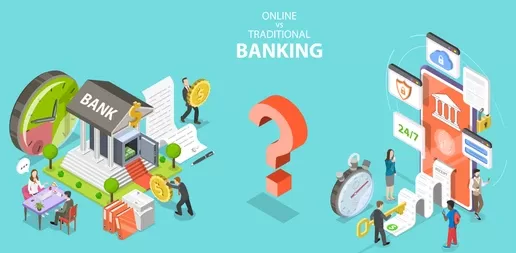Blog Details
Comparing Traditional vs. Online Banking: Which Suits You Better?
In an era where convenience is king, the landscape of banking is undergoing a profound transformation. The traditional brick-and-mortar banking experience is now sharing the stage with its digital counterpart, as more individuals explore the realm of online banking. In this blog, we delve into the heart of this financial revolution, comparing the strengths and weaknesses of traditional and online banking to help you determine which suits your needs best.
What Is Online Banking?
Online banking, the digital equivalent of ordering food through Swiggy or Zomato, has become an integral part of the modern banking experience. Financial institutions, both traditional and digital, offer online services. However, a new wave of banks operates exclusively online, eliminating the need for physical branches.
Over 75% of Americans prefer mobile or online banking over visiting a physical branch.
Online-only banks have gained popularity for their seamless digital transactions. The account setup is a breeze, requiring minimal information such as legal name, date of birth, and a social security number. Some even allow you to apply via phone or mail, highlighting the convenience they bring to the table.
Advantages of Online Banks
1. Lower Fees
Online-only banks often boast lower account fees compared to their traditional counterparts. Monthly maintenance fees are a rarity, and minimum deposit requirements are often non-existent.
2. Better Interest Rates
Enjoy higher interest rates on checking and savings accounts with online banks. The annual percentage yields (APYs) can outshine those offered by traditional banks, giving your money the opportunity to grow.
3. Large ATM Networks
Access thousands of ATMs with online-only banks, sometimes surpassing the availability of traditional banks. Some even reimburse ATM fees, enhancing convenience for account holders.
4. Convenience
With online banking, the world becomes your banking hall. Conduct transactions at any time, from anywhere, with just a computer or digital device.
5. Diverse Banking Services
Online-only banks extend beyond the basics, offering a range of services including money market accounts, certificates of deposit (CDs), mortgages, auto loans, personal loans, and investment options.
Digital channels, including online and mobile platforms, have emerged as the primary choice for borrowers when acquiring home loans.
Are Online Banks Better?
Online banks present a compelling case with their lower fees, higher interest rates, and round-the-clock accessibility. However, they may fall short in certain areas, prompting a closer look at the advantages of traditional banking.
Traditional Banking in a Digital Age
While online banking is on the rise, traditional banks still hold their ground, offering a different set of advantages.
1. Cash Deposits
Unlike online banks, traditional banks excel in handling cash deposits. Digital banks may require ATM transactions or fund transfers from traditional bank accounts for cash deposits.
2. Easier Cash Withdrawals
Digital banks may impose daily limits on ATM withdrawals, limiting your access to cash. Traditional banks, with tellers at physical branches, provide greater flexibility in cash withdrawals.
3. In-Person Customer Service
The absence of physical branches in online-only banks means customer service is often relegated to phone or live chat. Traditional banks offer the advantage of in-person assistance during regular business hours.
4. Broader Range of Accounts
Traditional banks typically provide a wider array of accounts and products, including safe deposit boxes and check-writing privileges, which may not be available in online-only banks.
5. Stability of Technology
In the event of technical issues with online functions, traditional banks with physical branches may still offer accessibility, ensuring you can conduct essential banking tasks.
Striking the Balance: The Bottom Line
Digital banking ushers in a host of benefits such as lower fees, competitive interest rates, and unparalleled convenience. However, it may not completely replace the traditional banking experience, especially for those who value in-person services, a broader range of accounts, and the stability of technology.
In a world where adaptability is key, consider embracing both worlds. Traditional banks can provide in-person services and accommodate cash transactions, while online banks offer the allure of low fees, high APYs, and advanced digital features. By combining the strengths of both, you can enjoy a banking experience tailored to your unique preferences and needs.
Navigating the Banking Landscape
As the financial landscape evolves, the choice between traditional and online banking becomes a matter of personal preference. Online banking stands as a testament to progress, offering a futuristic approach to managing your finances. Traditional banking, with its time-tested practices, continues to cater to those seeking a more tangible and comprehensive banking experience.
The key is not to choose one over the other but to find a harmonious balance that aligns with your lifestyle and financial goals. Embrace the future by navigating the banking landscape with a blend of traditional solidity and digital innovation.


